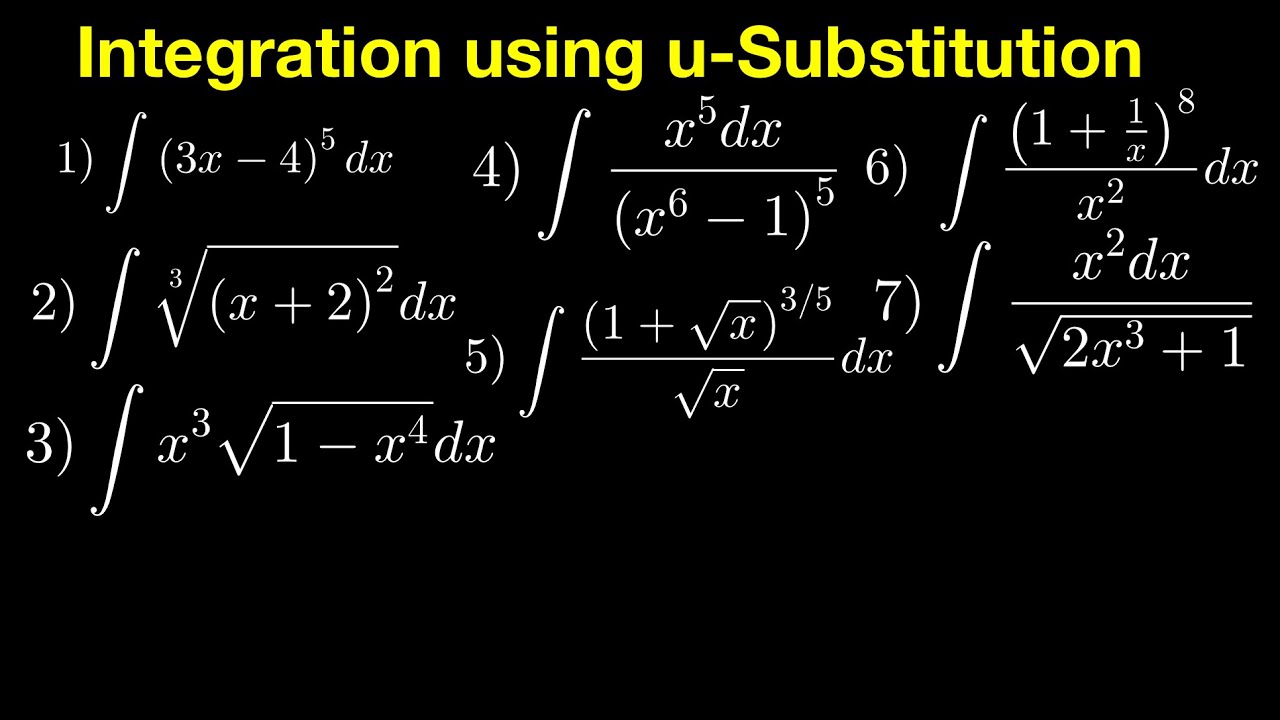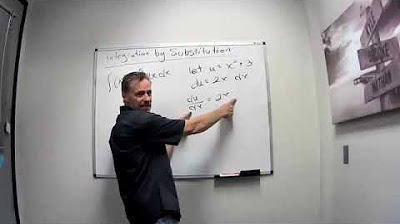Indefinite Integration (part IV)
TLDRThis video script introduces the concept of integration by substitution, a technique akin to reversing the chain rule in calculus. The presenter explains the method through step-by-step examples, starting with a review of the last session's work on sine of x and cosine of x integration. The script then delves into more complex integrals, such as polynomial functions and exponentials, demonstrating how to simplify them through substitution. The examples illustrate the process of identifying the function and its derivative for substitution, carrying out the integration, and finally reverting back to the original variables. The presenter's approach is pedagogical, aiming to clarify the concept for learners who may find direct integration challenging.
Takeaways
- 🔄 The video discusses reversing the chain rule during integration, specifically through the method of integration by substitution.
- 🌟 An example provided was the integral of sine of x to the third power times cosine of x, which was solved by treating sine of x as a variable and integrating it.
- 📚 The concept of treating the derivative of a function as a variable (u) was introduced to simplify the integral.
- 🧠 The derivative of u (in this case, sine of x) is used to replace the original function in the integral, which simplifies the process.
- 📈 The integral of 2x plus 3 times x squared plus 3x, plus 15 to the fifth power dx was used to demonstrate the technique of substitution.
- 🔢 The derivative of the expression (2x + 3) was identified, and the substitution was made to simplify the integral.
- 🌐 The video also covered the integral of e to the x times e to the x to the fifth power, showing how to identify u and du/dx in such scenarios.
- 🎓 The importance of understanding the relationship between u and du/dx was emphasized for successful integration by substitution.
- 🛠️ The video highlighted that sometimes, simplifying the expression before substitution can lead to a more straightforward solution.
- 📝 The process of substituting back from u to the original variable (e.g., sine of x) was demonstrated to obtain the final answer.
- 🔍 The video concluded by mentioning the potential for future presentations covering more complex problems using the integration by substitution technique.
Q & A
What is the main concept discussed in the video?
-The main concept discussed in the video is integration by substitution, which is a technique used to evaluate integrals by reversing the chain rule.
How does the chain rule relate to integration by substitution?
-Integration by substitution is essentially the reverse of the chain rule. It involves treating the function being integrated as a variable and its derivative as the constant, allowing for the application of integration techniques as if the function were a simple variable.
What was the first example given in the video to demonstrate integration by substitution?
-The first example given in the video was the integral of sine of x to the third power times cosine of x. The integral was solved by treating sine of x as a variable and using its derivative, cosine of x, to perform the integration.
What is the result of the first integral example in the video?
-The result of the first integral example, sine of x to the third power times cosine of x, is sine of x to the fourth times 1/4, plus a constant (c).
How does the process of integration by substitution help in understanding the relationship between functions and their derivatives?
-Integration by substitution helps in understanding the relationship between functions and their derivatives by allowing us to treat the function as a variable and its derivative as a constant. This perspective shift makes it easier to apply integration techniques and gain insights into how the function behaves under differentiation and integration.
What is the second example provided in the video, and how is the substitution made?
-The second example provided in the video is the integral of 2x plus 3 times x squared plus 3x, plus 15 to the fifth power dx. The substitution is made by letting u equal to x squared plus 3x plus 15, and recognizing that the derivative of u, du/dx, is 2x plus 3.
What is the result of the second integral example in the video?
-The result of the second integral example, 2x plus 3 times x squared plus 3x, plus 15 to the fifth power dx, is 1/6 u to the sixth power, plus a constant (c). After substituting back, it becomes 1/6 x squared plus 3x plus 15 to the sixth power, plus c.
How does the video explain the handling of differentials during integration by substitution?
-The video explains that differentials, such as dx and du dx, behave like regular numbers in a fraction. When they appear in the numerator and denominator of the same term, they can be canceled out, simplifying the integral.
What is the third example given in the video, and what is the significance of the choice of u in this example?
-The third example given in the video is the integral of e to the x times e to the x to the fifth power, to the minus third power dx. The choice of u in this example is significant because u is chosen as e to the x, and du/dx is also e to the x, which allows for a straightforward substitution and simplification of the integral.
What is the result of the third integral example in the video, and how is it simplified?
-The result of the third integral example, e to the x times e to the x to the fifth power, to the minus third power dx, is the integral of u to the minus 3 du, which simplifies to 1/2 u to the minus 2, plus a constant (c). After substituting back, it becomes 1/2 e to the x to the minus 2, or 1/2 e to the minus 2x, plus c.
What is the main takeaway from the video regarding the use of integration by substitution?
-The main takeaway from the video is that integration by substitution is a powerful technique for evaluating integrals, especially when the integrand involves the derivative of the function being integrated. By treating the function as a variable and its derivative as a constant, complex integrals can be simplified and solved more easily.
Outlines
📚 Introduction to Integration by Substitution
This paragraph introduces the concept of integration by substitution, which is a technique used to evaluate integrals. It begins by reviewing the previous presentation on reversing the chain rule for derivatives and then explains how this concept can be applied to integration. The speaker uses the example of integrating sine of x to the third power times cosine of x, which was previously solved by reversing the chain rule. The explanation continues with the process of treating sine of x as a variable and integrating it, leading to the result of sine of x to the fourth times 1/4. The paragraph then transitions into the technique of integration by substitution, starting with the same integral and explaining the process of substitution. The speaker demonstrates how to let u equal the function whose derivative is known (in this case, sine of x) and then how to substitute u and its derivative (cosine of x) into the integral. This substitution simplifies the integral to u to the third power times du, which is then easily integrated. The speaker emphasizes the importance of understanding the concept of differentials and how they behave in integration, leading to the final result of 1/4 u to the fourth plus c, with u being sine of x. The paragraph concludes by suggesting that this method might be easier for some to understand than the previous presentation's approach and mentions that more problems will be solved using this technique.
🔢 Applying Integration by Substitution to Complex Integrals
This paragraph delves into the application of integration by substitution to more complex integrals. The speaker begins by tackling the integral of a polynomial expression (2x + x squared + 3x + 15) raised to the fifth power. The process starts with identifying the derivative of the integrand, which turns out to be the original expression itself (2x + 3). The speaker then proceeds with the substitution, letting u equal the integrand and du/dx equal its derivative. This allows the integral to be rewritten in terms of u, simplifying it to the integral of u to the fifth power times du. The next example involves the integral of the product of e to the x and e to the x to the fifth power. The speaker explains that the derivative of e to the x is itself, which makes the substitution process straightforward. The integral is then rewritten in terms of u, with u being e to the x, and the integral solved by raising u to the power of (1 - 1/2) times the exponent, resulting in 1/6 u to the sixth power plus c. The speaker acknowledges that the problem could have been simplified without substitution, but emphasizes the importance of understanding the substitution method. The paragraph concludes with a promise to cover more challenging problems using integration by substitution in future presentations.
Mindmap
Keywords
💡Integration
💡Chain Rule
💡Integration by Substitution
💡Derivative
💡Antiderivative
💡Substitution
💡Differentials
💡Integral of a Product
💡Definite Integrals
💡e to the x
💡Constant of Integration
Highlights
Reversing the chain rule for integration is introduced as a key concept.
Integration by substitution is presented as an alternative method to reverse the chain rule.
The integral of sine of x to the third power times cosine of x is solved as an example.
The derivative of sine x is identified as cosine x, which is crucial for the substitution method.
The concept of treating trigonometric functions as variables for integration is explained.
Integration by substitution is demonstrated with the integral of a polynomial function involving x.
The derivative of the polynomial function x squared plus 3x plus 15 is calculated to facilitate the substitution.
The technique of substituting u for the function and du/dx for its derivative is applied to simplify the integral.
The integral of a complex expression involving e to the power of x is tackled using substitution.
The derivative of e to the x is highlighted as being the same function, e to the x.
The importance of choosing the correct u and du/dx for successful integration by substitution is emphasized.
The concept of canceling out differentials in the integration process is explained.
The final result of the integral is expressed in terms of the original variable x after substitution.
The potential confusion with integration by substitution is acknowledged for better understanding.
The concept of integration by substitution is reinforced as a valuable technique for solving integrals.
The session ends with a promise of more complex problems in future presentations, encouraging ongoing learning.
Transcripts
5.0 / 5 (0 votes)
Thanks for rating:





